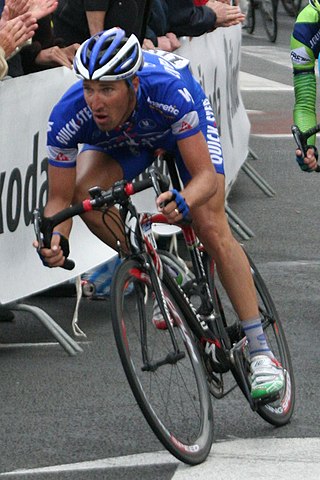Related Research Articles

Exercise physiology is the physiology of physical exercise. It is one of the allied health professions, and involves the study of the acute responses and chronic adaptations to exercise. Exercise physiologists are the highest qualified exercise professionals and utilise education, lifestyle intervention and specific forms of exercise to rehabilitate and manage acute and chronic injuries and conditions.

Anaerobic exercise is a type of exercise that breaks down glucose in the body without using oxygen; anaerobic means "without oxygen". In practical terms, this means that anaerobic exercise is more intense, but shorter in duration than aerobic exercise.
VO2 max (also maximal oxygen consumption, maximal oxygen uptake or maximal aerobic capacity) is the maximum rate of oxygen consumption attainable during physical exertion. The name is derived from three abbreviations: "V̇" for volume (the dot appears over the V to indicate "per unit of time"), "O2" for oxygen, and "max" for maximum. A similar measure is VO2 peak (peak oxygen consumption), which is the measurable value from a session of physical exercise, be it incremental or otherwise. It could match or underestimate the actual VO2 max. Confusion between the values in older and popular fitness literature is common. The capacity of the lung to exchange oxygen and carbon dioxide is constrained by the rate of blood oxygen transport to active tissue.

Exercise intensity refers to how much energy is expended when exercising. Perceived intensity varies with each person. It has been found that intensity has an effect on what fuel the body uses and what kind of adaptations the body makes after exercise. Intensity is the amount of physical power that the body uses when performing an activity. For example, exercise intensity defines how hard the body has to work to walk a mile in 20 minutes.

High-intensity interval training (HIIT) is a training protocol alternating short periods of intense or explosive anaerobic exercise with brief recovery periods until the point of exhaustion. HIIT involves exercises performed in repeated quick bursts at maximum or near maximal effort with periods of rest or low activity between bouts. The very high level of intensity, the interval duration, and number of bouts distinguish it from aerobic (cardiovascular) activity, because the body significantly recruits anaerobic energy systems. The method thereby relies on "the anaerobic energy releasing system almost maximally".

Excess post-exercise oxygen consumption is a measurably increased rate of oxygen intake following strenuous activity. In historical contexts the term "oxygen debt" was popularized to explain or perhaps attempt to quantify anaerobic energy expenditure, particularly as regards lactic acid/lactate metabolism; in fact, the term "oxygen debt" is still widely used to this day. However, direct and indirect calorimeter experiments have definitively disproven any association of lactate metabolism as causal to an elevated oxygen uptake.
Cardiorespiratory fitness (CRF) refers to the ability of the circulatory and respiratory systems to supply oxygen to skeletal muscles during sustained physical activity. Scientists and researchers use CRF to assess the functional capacity of the respiratory and cardiovascular systems. These functions include ventilation, perfusion, gas exchange, vasodilation, and delivery of oxygen to the body's tissues. As these body's functions are vital to an individual's health, CRF allows observers to quantify an individual's morbidity and mortality risk as a function of cardiorespiratory health.
Interval training is a type of training exercise that involves a series of high-intensity workouts interspersed with rest or relief periods. The high-intensity periods are typically at or close to anaerobic exercise, while the recovery periods involve activity of lower intensity. Varying the intensity of effort exercises the heart muscle, providing a cardiovascular workout, improving aerobic capacity and permitting the person to exercise for longer and/or at more intense levels.
Lactate inflection point (LIP), is the exercise intensity at which the blood concentration of lactate and/or lactic acid begins to increase rapidly. It is often expressed as 85% of maximum heart rate or 75% of maximum oxygen intake. When exercising at or below the lactate threshold, any lactate produced by the muscles is removed by the body without it building up.

Exertion is the physical or perceived use of energy. Exertion traditionally connotes a strenuous or costly effort, resulting in generation of force, initiation of motion, or in the performance of work. It often relates to muscular activity and can be quantified, empirically and by measurable metabolic response.
Performance-enhancing substances, also known as performance-enhancing drugs (PEDs), are substances that are used to improve any form of activity performance in humans. A well-known example of cheating in sports involves doping in sport, where banned physical performance-enhancing drugs are used by athletes and bodybuilders. Athletic performance-enhancing substances are sometimes referred as ergogenic aids. Cognitive performance-enhancing drugs, commonly called nootropics, are sometimes used by students to improve academic performance. Performance-enhancing substances are also used by military personnel to enhance combat performance.
Incremental exercise is physical exercise that increases in intensity over time.

The Bruce protocol is a standardized diagnostic test used in the evaluation of cardiac function and physical fitness, developed by American cardiologist Robert A. Bruce.
In sports, health and particularly exercise testing, the rating of perceived exertion (RPE), as measured by the Borg rating of perceived exertion scale, is a frequently used quantitative measure of perceived exertion during physical activity. In medicine this is used to document the patient's exertion during a test for the severity of diseases, and sports coaches use the scale to assess the intensity of training and competition as well as endurance. The original scale introduced by Gunnar Borg rated exertion on a scale of 6-20. Borg then constructed a newer category (C) ratio (R) scale, the Borg CR10 scale, rated on a scale from 1-10. This is especially used in clinical diagnosis and severity assessment of breathlessness and dyspnea, chest pain, angina and musculo-skeletal pain. The CR-10 scale is best suited when there is an overriding sensation arising either from a specific area of the body rather than overall exertion, for example, muscle pain, ache or fatigue in the quadriceps or from pulmonary responses during exertion.

Glycine propionyl-L-carnitine (GPLC) is a propionyl ester of carnitine that includes an additional glycine component. Due to tissues esterases enzymes, GPLC should act as a prodrug and lead to glycine, carnitine and propionic acid in the body.
The interplay of exercise and music has long been discussed, crossing the disciplines of biomechanics, neurology, physiology, and sport psychology. Research and experimentation on the relation between music and exercise dates back to the early 1900s, when investigator Leonard Ayres found that cyclists pedaled faster in the presence of a band and music, as opposed to when it was silent. Since then, hundreds of studies have been conducted on both the physiological and psychological relationship between music and physical activity, with a number of clear cut relationships and trends emerging. Exercise and music involves the use of music before, during, and/or after performing a physical activity. Listening to music while exercising is done to improve aspects of exercise, such as strength output, exercise duration, and motivation. The use of music during exercise can provide physiological benefits as well as psychological benefits.
The lactate shuttle hypothesis describes the movement of lactate intracellularly and intercellularly. The hypothesis is based on the observation that lactate is formed and utilized continuously in diverse cells under both anaerobic and aerobic conditions. Further, lactate produced at sites with high rates of glycolysis and glycogenolysis can be shuttled to adjacent or remote sites including heart or skeletal muscles where the lactate can be used as a gluconeogenic precursor or substrate for oxidation. The hypothesis was proposed by professor George Brooks of the University of California at Berkeley.
Central nervous system fatigue, or central fatigue, is a form of fatigue that is associated with changes in the synaptic concentration of neurotransmitters within the central nervous system which affects exercise performance and muscle function and cannot be explained by peripheral factors that affect muscle function. In healthy individuals, central fatigue can occur from prolonged exercise and is associated with neurochemical changes in the brain, primarily involving serotonin (5-HT), noradrenaline, and dopamine. Central fatigue plays an important role in endurance sports and also highlights the importance of proper nutrition in endurance athletes.
In kinesiology, the ventilatory threshold (VT1) refers to the point during exercise at which ventilation starts to increase at a faster rate than VO2 (V – volume, O2 – oxygen). One's threshold is said to reflect levels of anaerobiosis and lactate accumulation. As the intensity level of the activity being performed increases, breathing becomes faster; more steadily first and then more rapid as the intensity increases. When breathing surpasses normal ventilation rate, one has reached ventilatory threshold. For most people this threshold lies at exercise intensities between 50% and 75% of VO2 max. A major factor affecting one's ventilatory threshold is their maximal ventilation (amount of air entering and exiting lungs). This is dependent on their personal experience with the activity and how physically fit the person is. Comparison studies of more athletic people have shown that your ventilatory threshold occurs at a higher intensity if you are more active or have been training for that exercise; although, in some cases shorter continuous tests can be used because of rapid alterations in ventilation.
The physiology of marathons is typically associated with high demands on a marathon runner's cardiovascular system and their locomotor system. The marathon was conceived centuries ago and as of recent has been gaining popularity among many populations around the world. The 42.195 km distance is a physical challenge that entails distinct features of an individual's energy metabolism. Marathon runners finish at different times because of individual physiological characteristics.
References
- 1 2 3 Karageorghis, C.I., & Terry, P.C. (1997). The psychophysical effects of music in sport and exercise: A review. Journal of Sport Behavior, 20, 54–68.
- 1 2 Nethery VM. Competition between internal and external sources of information exercise: influence on RPE and the impact of the exercise load. J Sports Med Phys Fitness 2002.
- ↑ Schwartz SE, Fernhall B, Plowman SA. Effects of music on exercise performance. J Cardiovasc Pharmacol 1990; 10:31 2-6.
- 1 2 Yamashita, S., Iwai, K., Akimoto, T., Sugawara, J., & Kono I. (2006). Effect of music during exercise of RPE, heart rate and the autonomic nervous system. Journal of Sports Medical Physical Fitness, 46, 425-430.
- 1 2 3 Rejeski, W.J. (1985). Perceived exertion: An active or passive process? Journal of Sport Psychology, 75, 371–378.
- 1 2 Umemura, M. & Honda, K. Influence of music on heart rate variabiliry and comfort:a consideration through comparison of music and noise. Journal of Human Ergology (Tokyo), 27, 30-38.
- ↑ Boutcher, S. & Trenske, M. (1990). The effects of sensory deprivation and music on perceived exertion and affect during exercise. Journal of Sports Exercise Psychology, 12, 167-176.
- ↑ Szmedra L, Bacharach DW. Effect of music on perceived exertion, plasma lactate, norepinephrine and cardiovascular hemodynamics during treadmill running. Int. J Sports Med 1998; 19:32-7.
- 1 2 3 4 5 Hagen, J., Foster, C., Rodríguez-Marroyo, J., De Koning, J. J., Mikat, R. P., Hendrix, C. R., & Porcari, J. P. (2013). The effect of music on 10-km cycle time-trial performance. International Journal of Sports Physiology & Performance, 8 (1), 104-106.
- ↑ Bigliassi, M., Dantas, J. L., Carneiro, J. G., Smirmaul, B. P. C., & Altimari, L. R. (2012). Influence of music and its moments of application on performance and psychophysiological parameters during a 5km time trial. Revista Andaluza De Medicina Del Deporte Revista Andaluza De Medicina Del Deporte, 5 (3), 83-90.
- 1 2 Lucaccini, L.F., & Kreit, L.H. (1972). Music. In W.P. Morgan (Ed.), Ergogenic aids and muscular performance (pp. 240–245). New York: Academic Press.
- ↑ <Bishop, D.T., Karageorghis, C.I., & Loizou, G. (2007). A grounded theory of young tennis players’ use of music to manipulate emotional state. Journal of Sport & Exercise Psychology, 29, 584–607/>.
- ↑ Karageorghis, C.I., Drew, K.M., & Terry, P.C. (1996). Effects of pretest stimulative and sedative music on grip strength. Perceptual and Motor Skills, 83, 1347–1352.
- 1 2 Karageorghis, C. I., Mouzourides, D. A., Priest, D. L., Sasso, T. A., Morrish, D. J., & Walley, C. J. (2009). Psychophysical and ergogenic effects of synchronous music during treadmill walking. Journal of Sport & Exercise Psychology, 31(1), 18-36.